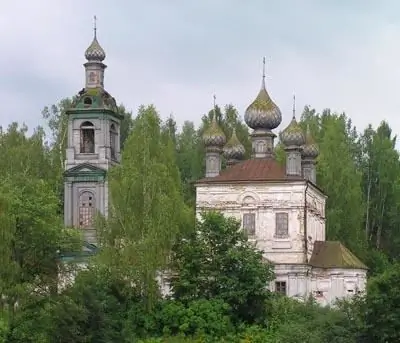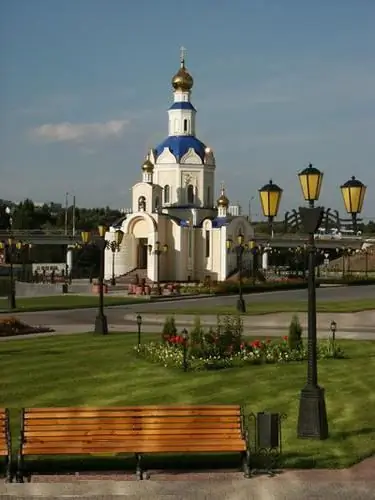- Author Harold Hamphrey [email protected].
- Public 2023-12-17 10:06.
- Last modified 2025-01-24 11:10.
Place de la Bastille is one of the most famous places in Paris. It received this name due to the historical fortress that once stood there. The huge square (215x150 m) became the scene of many revolutions that had significant consequences for the history of France. This place is still the most important point of the French capital for demonstrations, processions and public celebrations.
Description of Place de la Bastille
This symbol of the French Revolution has had a turbulent history. It was here that the famous Bastille prison was located, destroyed stone by stone during the coup. In its center, a beautiful July column is visible from afar, which is crowned with a statue of the Spirit of Freedom.
One of the other iconic monuments in the square is, of course, the Bastille Opera House. This modern building, opened in 1989, was built by Carlos Ott to replace the old station.
Today Place de la Bastille is one of the very busy intersections in Paris with numerousintersecting streets. It also serves as a popular meeting place for young Parisians in the evenings on the terraces of cafes and breweries, as well as a favorite place for political meetings, parades, social marches, concerts and festive events.
And while the history of the Bastille with its fortress-turned-prison is fascinating, unfortunately, none of the original buildings remain intact.

If tourists had gone on holiday to Paris in the 1980s, they would have found that the area was more of a working-class area and there was nothing to be seen around Place de la Bastille itself, except for the July Column in the center and an old railway station called Gare de Vincennes. But a lot has changed since then.
The old train station has been there since 1859, but was closed in 1969 and demolished in 1984 to make way for the new Opera in Paris.
To celebrate the bicentenary of the French Revolution in July 1989, the imposing modern Opera House was erected and opened on 14 July. There has also been a significant rebuilding of the surrounding area and the street around the square.
Through these actions, the area has become a chic and popular place with numerous clubs, galleries, theaters, bars and restaurants in Paris, which are now very popular among both tourists and the Parisians themselves.
Bastille Fortress
After the defeat of the French at Poitiers in 1356 during the Hundred Years' War with England, a fortress was needed to protect Paris from invasion.
BIn 1370, Charles V began to build a large fortress on the site of the fortified gates. Construction was completed in 1382. It was called the fortress of the Bastille. The massive building had walls 4 meters wide and 8 towers 22 meters high.
Over the centuries, it has changed its purpose, becoming an armory, a reception room under Francis I and a safe of the royal treasury under Henry IV. But it was Cardinal de Richelieu who, during the reign of Louis XIII, made it a state prison, in which all opponents of the king and his regime were locked up. Among the most famous prisoners are Voltaire, Michel Montaigne, Beaumarchais and the Marquis de Sade. The fortified prison was demolished between July 14, 1789 and July 14, 1790, and its stones were partly used to build the Pont de la Concorde (an arched bridge over the River Seine in Paris).

The Storming of the Bastille
On July 14, 1789, the Bastille was stormed by a mob reinforced by a rebellious detachment of the National Guard. Several guards soon surrendered and seven prisoners were released.
The capture of the fortress marks the beginning of the French Revolution. The event is celebrated each year as Bastille Day, which was declared a French national holiday in 1860.
Two days after the mobs took over the Bastille fortress, orders were given to demolish the building. The only traces of the past are on the ground: a triple row of cobblestones that bound the old site.
Creating a square
Place de la Bastille appeared in 1803. She was built onthe site of the fortress and fortifications of Charles V, who marked the border between Paris and the Faubourgs (suburbs).
It included the 24-metre-tall elephant-shaped fountain referenced by Victor Hugo in his novel Les Misérables. It was dismantled in 1847.

On July 14, 1790, entrepreneur Pierre-François Palloy organized the first popular dance ball to celebrate Independence Day. Among the ruins of the former prison, he set up a tent with the inscription: Ici on danse (people dance here). This tradition has survived to this day.
From June 9 to June 14, 1794, the infamous guillotine was located on the square. 75 people were beheaded here before this execution weapon was moved to the current Nation Square.
July Column
The monumental July Column (Colonne de Juillet) commissioned by Louis Philippe in 1830 and inaugurated in 1840. The height of the Corinthian style column is 50.52 meters. It was designed by the architects Jean-Antoine Alavone and Joseph-Louis Duc. A staircase with 140 steps leads to the observation deck. Its name refers to the three glorious days of July 27-29, 1830 (July Revolution), when King Charles X was rejected by the "July Monarchy" of Louis Philippe. The commemorative plaque is inscribed in honor of French citizens who armed themselves and fought to defend public freedoms.

At the top of the column is a gilded angel by Auguste Dumont called "The Spirit of Liberty". The statue holds the torch of civilization andremnants of his broken chains.
The July Column is visible from many viewing platforms in Paris: the Sacré Coeur in Montmartre, the Père Lachaise cemetery, the towers of Notre Dame and Montparnasse, the Arab World Institute.
Bastille Opera
There used to be a railway station on the site of the Opera, opened between 1859 and 1969. It was demolished in 1984 to make way for an ambitious project, the modern Bastille Opera. Former railroads have been converted into a waterfront.
The Bastille Opera is part of François Mitterrand's Grand Projects, a grandiose plan that included the construction of the Great Arch of Defence, the National Library and the glass pyramid of the Louvre.
The building was built between 1984 and 1989. Its opening coincided with the bicentenary of the French Revolution. The opera was designed by Uruguayan architect Carlos Ott and has a seating capacity of 3,309.

Interesting facts
There are many interesting facts about Place de la Bastille:
- Marking on Boulevard Henri IV shows where the former fortress building was located. Some of the foundation stones are visible at the Bastille metro station, on line 5, where you can also see a line on the floor that marks the exact location of the former fortress.
- On the site of Place de la Bastille in Paris, Emperor Napoleon Bonaparte wanted to create a copy of the Arc de Triomphe - the elephant of the Bastille. This project was never completed and today only the round base of the fountain remains. Interestingly, an exact copy of the monument was built in Mexico City in 1910.
- The largest remains of the fortress can be found in Place Henri Galli, located southwest of Place de la Bastille at the end of Boulevard Henri IV.
- The Bastille was unique in French prisons at the time because prisoners could be sent there for the crimes they committed without a trial. Instead, petty criminals were issued a letter stating that they would be arrested and imprisoned. Because these prisoners did not have to face trial, their reputations were not affected. This has led many aristocratic families to decide to send family members who have committed minor crimes to this prison in order to maintain their reputation. The French monarchy until 1789 planned to close it for this very reason.
Today's Square
Today, the square often hosts open-air concerts and festivals, as well as political demonstrations. The south side of the square is a popular ice skating spot.
There is a metro station under Place de la Bastille, and it can be reached by lines 1, 5 and 8. In fact, it was during the excavation of the area for the construction of the metro station that some sections of the foundations of the old fortress were discovered, which can be found in the park at Place Henri -Galli, located near Henry IV Boulevard.

Behind the square there is a pier for pleasure boats. It is located on the first section of the Canal Saint-Martin, which begins on the River Seine. There are many different types of walkingboats, river boats. It is possible to take a short canal cruise from the Bassin de l'Arsenal, which passes through the tunnels under the old foundations of the fortress and the square itself. The boat then goes outside and passes through several locks before reaching Bassin. This is an unusual way to look at such a landmark of Paris as Place de la Bastille from a completely different angle.
Tourists who prefer to be on land also have something to offer. After leaving the square and turning right from the Opera, and then going to Daumesnil Avenue, you can climb the stairs to the embankment. There is a beautiful garden that was planted along the old railway viaduct, and tourists can walk through it to the Bois de Vincennes.






